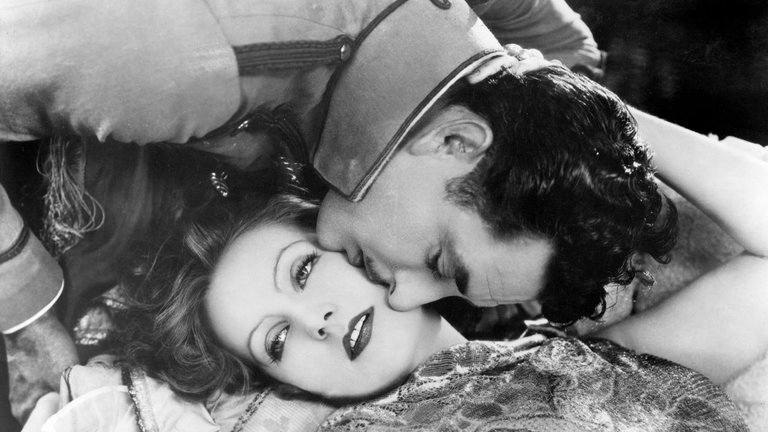Film Review: Flesh and the Devil (1926)

A century ago there were many popular writers who would have been completely forgotten by now if not for their works becoming popular literary source for many classic works of emerging film industry. One of those most fortunate among them was Hermann Sudermann, German writer whose staunch nationalism would posthumously make him favourite writer of Nazi regime, and, consequently, something of a “non-person” in post-Nazi Germany. Sudermann, however, didn’t have those problems in Hollywood, which would adapt his short story “The Excursion to Tilsit” into Sunrise, often considered to be the greatest of all Hollywood silent films. A year before Sunrise Sudermann’s 1894 novel Er Was (“It Was”, published in English as The Undying Past) served as basis for Flesh and the Devil, melodrama directed by Clarence Brown which was one of the most popular films of its time.
The plot is set in Imperial Germany at the turn of 20th Century. Protagonist, played by John Gilbert, is young aristocrat Leo von Harden who serves as military cadet together with his best friend Ulrich von Eltz (played by Lars Hanson). During the furlough he returns to his home town and meets beautiful woman named Felicitas (played by Greta Garbo) and becomes infatuated with her. She easily get charmed by dashing officer and two of them starts passionate love affair which is cut short with arrival Count von Rhaden (played by Marc McDermott), who introduces himself as Felicitas’ husband and demands that his honour be restored through duel. Leo obliges and kills Count, but his deed, which he, trying to preserve dead man’s dignity, explained with card game quarrell, results in military authorities “advising” him to serve five years as officer in German Southwest Africa. Ulrich through his friends in high place manages to reduce his sentence and Leo is allowed back in Germany only after three years. After arrival he realises that Ulrich, unaware of his affair, has married widowed Felicitas. This causes him great pain because he deliberately distances himself from his best friend, afraid that he would, upon seeing Felicitas, again succumb to temptation. Ulrich’s illness makes this encounter just as inevitable as rekindling of lovers’ passion.
Flesh and the Devil is the best known as the film who made Greta Garbo into proper Hollywood icon. Although she had already made two films for MGM, Swedish actress, who was barely 21 years at the time, still had to prove her stellar power. This she did mostly thanks to very fortunate casting choice. John Gilbert, who, following death of Rudolph Valentino, had ascended the throne of Hollywood’s greatest heartthrob, was playing role tailor-made for his persona and, despite its limits, showed great acting skills. But it was the great chemistry he had discovered with Garbo that was key to success of the film. That chemistry also found itself in real life, resulting in romance that would fill tabloid headlines for number of years and provide free publicity for Flesh and the Devil. Talents of Gilbert and Garbo were complemented by talents of director Clarence Brown and cinematographer William H. Daniels. The latter has found many innovative techniques to light Garbo’s face in a way to make her ethereally beautiful and thus create one of the greatest icons in history of Hollywood. Brown directed film in a solid manner, and, although not displaying experimental audacity of his contemporaries like Murnau, Gance or Eisenstein, left great impression on Garbo. This was partly because Brown had been aware of what was going on between his two actors and didn’t actually feel any need to direct them in love scenes. Garbo would gain enough Hollywood clout to choose her directors, and Brown would later direct Garbo in six of his films.
The rest of the cast is also quite good, including Lars Hanson, actor with whom Garbo worked in native Sweden in The Saga of Gösta Berling. Elderly George Fawcett makes very good impression as Pastor Voss, character who is aware of what is going with Leo and Felicitas and tries to warn young man what awaits him. Flesh and the Devil is, however, far from perfect. Sense of style and capable cast is used on rather weak and uninspired plot drenched in melodrama. General impression is, however, rescued by ending which, despite plenty of melodrama and convenient plot developments, looks surprising and somewhat unusual, although some of today’s audience would call plot resolution slightly misogynistic. Yet, despite those flaws, Flesh and the Devil deserves the recommendation, at least for the silent cinema aficionados and those want to know how the great screen legends of 20th Century were made.
RATING: 7/10 (+++)
Blog in Croatian https://draxblog.com
Blog in English https://draxreview.wordpress.com/
InLeo blog https://inleo.io/@drax.leo
InLeo: https://inleo.io/signup?referral=drax.leo
Unstoppable Domains: https://unstoppabledomains.com/?ref=3fc23fRc42c1b417
Hiveonboard: https://hiveonboard.com?ref=drax y
Bitcoin Lightning HIVE donations: https://v4v.app/v1/lnurlp/qrcode/drax
Rising Star game: https://www.risingstargame.com?referrer=drax
1Inch: https://1inch.exchange/#/r/0x83823d8CCB74F828148258BB4457642124b1328e
BTC donations: 1EWxiMiP6iiG9rger3NuUSd6HByaxQWafG
ETH donations: 0xB305F144323b99e6f8b1d66f5D7DE78B498C32A7
Posted using CineTV